LordM BST archive, 3/4/11
 lordmarcovan
Posts: 43,658 ✭✭✭✭✭
lordmarcovan
Posts: 43,658 ✭✭✭✭✭

Welcome to my BST Forum "mini store"!
TERMS OF SALE: A modest contribution towards shipping costs is appreciated (add appropriate amount for insurance if desired). Generally I ask no more than dollar or two for uninsured shipments of one or two coins. Insured shipments require a 20-mile drive to the post office (as I live out in the country), so figure $3-5 or so, at your discretion (more for valuable Registered Mail shipments). I usually prefer to send shipments under $50 value uninsured so I can mail them straight from my home mailbox instead of going into town, but that is up to you. I will package the coins securely in a bubble mailer either way. PayPal is fine.
If you use PayPal, PLEASE add your forum name to the payment so I know who you are and what you are buying!
Full return privilege if you are not 100% satisfied. My return privilege is very flexible and has rarely been necessary. The only thing I ask is that you notify me as soon as you can if there is a problem or concern of any kind.
Should I ever disappear from the forums and the computer for several days to a week or more, as I sometimes do, and you need to reach me, feel free to call (912) 261-8408 and ask for Rob. I check PMs more than I do email, so emailing me in the event of a forum absence won't help much- usually when I am away, I am away from the computer entirely.
Reasonable counteroffers or trades? Put your best foot forward... I'm listening!

Below are some leftovers from my old Roman Imperial collection, which I was forced to break up when I got laid off in 2008. Since then, I've resumed collecting Roman coins (I love this stuff!) but now I'm focusing exclusively on the "Twelve Caesars" (Julius Caesar through Domitian). Got a nice coin of Augustus, Caligula, Claudius, Nero, Galba, Vitellius, or Titus to sell or swap? Let me know! Oh- and if you've always thought these kind of coins were interesting but have never collected any, don't be afraid- jump right in! They're not as hard to study as most people think, and the Web is full of free reference material. Also, they're often a lot less expensive than you'd think, considering the rarity of some of them.
 Roman Empire, bronze As of NERVA (96-98 AD), nice patina
Roman Empire, bronze As of NERVA (96-98 AD), nice patinaNERVA, Augustus 96-98 AD. AE as. Obverse- IMP NERVA CAES AVG P M TR P COS III P P, laureate head right. Reverse- CONCORDIA EXERCITVVM S-C, clasped hands. RIC-79, Cohen-21. 27.8 mm, 12.8 g. Ex-Ancient Imports, 05/2007. Asking $169, which is my cost.
 Roman Empire: bronze sestertius of LUCIUS VERUS (161-169 AD), struck 164 AD.
Roman Empire: bronze sestertius of LUCIUS VERUS (161-169 AD), struck 164 AD.LUCIUS VERUS, Augustus 161-169 AD (with Marcus Aurelius). AE sestertius, 164 AD. Obverse- L AVREL VERVS AVG ARMENIACVS, laureate head right. Reverse- TR P IIII IMP II COS II S-C, Victory standing right, placing a shield inscribed VIC/AVG in two lines on palm. RIC-1396, Cohen-249. 33.79 mm, 23 g. Ex-Ancient Imports, 05/2007. Asking $73, which is my cost.
 Roman Empire, silver antoninianus of VALERIAN II (ca. 253-257 AD), posthumous issue
Roman Empire, silver antoninianus of VALERIAN II (ca. 253-257 AD), posthumous issueVALERIAN II, Caesar under Valerian I, ca. 253-257 AD. AR antoninianus, posthumous issue.
Obverse- DIVO VALERIANO CAES, radiate and draped bust right. Reverse- CONSACRATIO, Valerian riding on eagle flying right.
RIC-9, RCV-10606, Sear-3071. 22 mm, 3.3 g. Ex-Incitatus Coins (Canada), 03/2008. Asking $59, which is my cost.
 Roman Empire, silvered bronze antoninianus of CLAUDIUS II "GOTHICUS" (268-270 AD), pedigreed hoard coin
Roman Empire, silvered bronze antoninianus of CLAUDIUS II "GOTHICUS" (268-270 AD), pedigreed hoard coinCLAUDIUS II (Claudius II Gothicus), Augustus 268-270 AD. AE silvered antoninianus, Antioch Mint. Obverse- IMP C CLAVDIVS AVG, radiate, draped & cuirassed bust right. Reverse- VIRTVS AVG, Minerva standing right resting on shield and holding spear, S in exergue. 21.75 mm, 4.2 g. Wildwinds reference page here. Ex-Ancient Imports, 05/2007, C.J. Martin (from a hoard found in Syria), 1984. Asking $43, which is my cost.
 Roman Empire: bronze antoninianus of QUINTILLUS (270 AD), scarce emperor- ruled less than a year
Roman Empire: bronze antoninianus of QUINTILLUS (270 AD), scarce emperor- ruled less than a yearQUINTILLUS, Augustus 270 AD. Obverse- radiate and draped bust right. Reverse- Securitas standing left, leaning on column and holding scepter. RIC-31, Cohen-63, Sear-11451 21 mm, 3 g. Ex-Incitatus Coins (Canada), 05/2007. Asking $39, which should be my cost or a little below it, but since online records of that purchase are gone and I don't remember what I paid, just make me an offer.
 Roman/Palmyrene Empire, bronze antoninianus of VABALATHUS (266-272 AD), struck ca. 271 AD, nice desert patina
Roman/Palmyrene Empire, bronze antoninianus of VABALATHUS (266-272 AD), struck ca. 271 AD, nice desert patinaVABALATHUS was king of the breakaway Palmyrene empire under his mother, Zenobia, ca. 266-272 AD. This was initially with the acquiescence of the Roman emperor Aurelian (who was busy fighting on other fronts), but Aurelian later conquered Palmyra in 273. This bronze antoninianus was struck at Antioch around 271 AD and shows dual portraits of Aurelian and Vabalathus, perhaps in expression of the Palmyrene hope that Aurelian would allow them to coexist. Obverse- VABALATHVS V CRIMDR, Laureate and draped bust right. Reverse- IMP C AVRELIANVS AVG, Radiate and draped bust right. (Which side is considered the obverse and which is the reverse is up for debate on a two-headed coin, but more folks probably use this type to represent Vabalathus in collections.) RIC-381. 20.62 mm, 3.3 g. Ex-Ancient Imports, 05/2007. Asking $69, which is my cost.
 Roman/Gallic Empire, bronze antoninianus of TETRICUS I (ca. 270-274 AD)
Roman/Gallic Empire, bronze antoninianus of TETRICUS I (ca. 270-274 AD)TETRICUS I was emperor of the breakaway Gallic Empire from circa 270 (or 271) AD until 273 (or 274) AD. (As is often typical of the Crisis of the Third Century,sources sometimes differ on the exact dates). He ruled with his son Tetricus II, until they were defeated by Aurelian and the Gallic provinces were brought back under the dominion of Rome. AE antoninianus. Obverse- IMP TETRICVS P F AVG, radiate, cuirassed bust right. Reverse- HILARITAS AVGG, Hilaritas standing left, holding palm and cornucopiae. RIC-80, Cohen-57. 19.6 mm, 2.3 g. Ex-Ancient Imports, 05/2007. Asking $34, which is my cost.
 Roman Empire, bronze antoninianus of FLORIAN (276 AD), rare emperor- ruled only 88 days!
Roman Empire, bronze antoninianus of FLORIAN (276 AD), rare emperor- ruled only 88 days!Florian is a rare emperor. He ruled for a mere 88 days before being killed by his own troops, which was a-common occupational hazard for 3rd century Roman emperors. That was 1,735 years ago. Who knows how many coins with his portrait were struck, and how many of them survive today?
FLORIAN(US), AE antoninianus, 276 AD. Obverse: IMP C FLORIANVS AVG, radiate, draped, and cuirassed bust right. Reverse: CLEMENTIA TEMP, Clementia standing left with scepter, leaning on column, XXIZ in exergue. 22 mm, 3.7 g. Ex-Nemesis Ancients & Antiquities, 07/2008. Asking $90, which is my cost.
 Roman Empire: bronze antoninianus of CARUS (282-283 AD), posthumous issue struck ca. 283 AD
Roman Empire: bronze antoninianus of CARUS (282-283 AD), posthumous issue struck ca. 283 ADCARUS, Augustus 282-283 AD. Posthumous AE antoninianus, Siscia mint, ca. 283 AD. Obverse- DIVO CARO PARTHICO, radiate head right. Reverse- CONSECRATIO AVG, flaming altar, A to right, SMSXXI in exergue. RIC-111 var., Cohen-23, Venera-4341. 21 mm, 3 g. Ex-Ancient Imports, 05/2007, Harmer Rooke 1988. Asking $55, which should be my cost or a little below it, but since online records of that purchase are gone and I don't remember what I paid, just make me an offer.
 Unattributed late Roman bronze AE3/centenionalis, ca. 4th century (after 348 AD)
Unattributed late Roman bronze AE3/centenionalis, ca. 4th century (after 348 AD)Bronze with greenish patina, 20.5 x 21.5 mm. I can't quite make out the obverse legends, though a good bit of them are visible. This coin has the stylized "stock portrait" of an emperor (most likely of the Constantinian dynasty) facing right on the obverse, and the well-known reverse design with a soldier spearing a fallen horseman. No doubt the reverse legend once read "FEL TEMP REPARATIO", which was the Romans' way of saying "Happy Days Are Here Again". (They weren't- the empire was in decline.) There is a fairly clear mint name in the exergue at the bottom of the reverse, but I'm not quite up to speed on those. (Siscia, perhaps?) $6.
 Unattributed late Roman bronze AE2 (Valentinian?), circa 4th century (after 364 AD)
Unattributed late Roman bronze AE2 (Valentinian?), circa 4th century (after 364 AD)Nice slightly-larger bronze with dark patina and fairly sharp details. The obverse legend pretty clearly says "VALENTINIAN", but which Valentinian? There were three. Valentinian I ruled from 364-375 AD, Valentinian II from 375-392 AD, and Valentinian III from 425 to 455 AD. I suspect the coin is from one of the earlier two Valentinians, because by the fifth century the bronze coins were usually much smaller and cruder than this. In fact, I think Valentinian II is our best candidate here because Wildwinds lists a few of his coins with this "GLORIA ROMANORVM" reverse, which features the emperor standing in a galley (ship). I believe the mint name in the exergue at the bottom of the reverse refers to Antioch. $12.
 Unattributed late Roman bronze AE4 (Theodosius?), circa 4th-5th century
Unattributed late Roman bronze AE4 (Theodosius?), circa 4th-5th centurySmall 15 mm bronze. Pretty clearly says "THEODOSIVS" on the obverse, so it should be either Theodosius I ("Theodosius the Great"), circa 379-395 AD, or Theodosius II, circa 408-450 AD. I lean towards the former of the two in my assessment. This coin looks truly wretched in the scans but has nice semi-gloss patina and sharp detail in hand. It's just one of those pieces that doesn't scan well. (Yes, I have resumed using my scanner since getting proper coin photography focus with my wife's camera has been driving me crazy lately). Looks MUCH better in hand. $8.
 Medieval Bohemia, silver pragergroschen ("Prague groschen"), ca. 1300s-1400s
Medieval Bohemia, silver pragergroschen ("Prague groschen"), ca. 1300s-1400sSilver, 32 mm. Obverse- crown. Reverse- Bohemian crowned lion. Bohemia was in what is now the Czech Republic. Admittedly, this is not the best-struck or best-preserved example, but you can make out the lion on the reverse, and it's clearly identifiable. See the Wikipedia page for more information, and a picture of a nicer example that should give you a better idea of the design. I have no idea what this is worth, so I'll pull a number out of thin air and ask $16. SOLD

 Australia, George V large penny, 1927(m), VF+
Australia, George V large penny, 1927(m), VF+KM23, bronze. Take this coin for free if you buy the collection below- it is slightly better than the 1927 in that album. $3.
 Australia, predecimal large penny collection in Dansco album, Fine to AU+, 72 pieces, lacks only 3 coins
Australia, predecimal large penny collection in Dansco album, Fine to AU+, 72 pieces, lacks only 3 coinsHere's a nearly-complete collection of Australian predecimal large pennies, from George V, George VI, and Elizabeth II, spanning all the dates and mints between 1911 and 1964. They are housed in a like-new Dansco #7331 album. Only three coins are missing: the rare 1925, the nearly-impossible 1930, and the tough-but-obtainable 1946. Everything else is there. I am selling this set exactly as I received it- some of the coins could benefit from a little conservation, like the 1913, which has old adhesive tape on the obverse (that might respond to acetone treatment). A few others have modest circulation scuz (dirt) or light verdigris that should be easily removed with a harmless Vaseline rub or oil soak. A few pieces have old cleaning but that has retoned in most cases. Most of the coins are problem free and brown, with some of the later pieces displaying varying degrees of original mint red. Since Australian coins are dated on the reverse, these are put in the album with the reverses facing forward. Click the links below to see low-res pictures of each page. Asking $122 but I'll consider any offer over $99.
Page 1 front (1911-1921 reverses) ~ Page 1 back (1911-1921 obverses)
Page 2 front (1922-1936 reverses) ~ Page 2 back (1922-1936 obverses)
Page 3 front (1938-1946 reverses) ~ Page 3 back (1938-1946 obverses)
Page 4 front (1947-1955 reverses) ~ Page 4 back (1947-1955 obverses)
Page 5 front (1955-1964 reverses) ~ Page 5 back (1955-1964 obverses)
For those of you who might lack a Krause catalog, I've copied and pasted screenshots from the 2009 Krause DVD for your reference and convenience.
George V values ~ George VI values ~ Elizabeth II values
 Belgian Congo, 2 francs, 1943, XF
Belgian Congo, 2 francs, 1943, XFKM25, brass. Approximately 15 mm along each flat side. Belgium was in German hands in 1943, while the Second World War raged, and the Nazi occupiers struck nasty zinc coins in the homeland, but apparently that didn't stop the colonies from producing cool coins like this. I mean, hey- a hexagon-shaped coin with an elephant on it? You gotta love that. $15. SOLD
 British West Africa, 1/2 penny of Edward VIII, 1936, BU
British West Africa, 1/2 penny of Edward VIII, 1936, BUKM15, copper-nickel, 25.5 mm. This coin has ample cartwheel luster not seen in the scans. It is off-white with the faintest gold coloration, and the color is uniform, despite what some of the shadowing in the pictures would have you believe. Back when I was collecting British coins by monarch, I had to settle for one of these colonial issues to represent the short reign of Edward VIII, since homeland issues with his portrait are prohibitively rare. This is a nice piece, and undervalued in Krause, in my opinion. $6. SOLD

 German States (Wurttemberg), 2 marks, 1907-F, ANACS AU58 Details (cleaned)
German States (Wurttemberg), 2 marks, 1907-F, ANACS AU58 Details (cleaned)KM631, .900 silver/.3215 oz, 28 mm. Though this coin has a rather flat appearance due to some unfortunate overdipping, it has really sharp details. I couldn't see any wear on it even with my reading glasses, so one would probably need a loupe to see any rub on it. This is a $100 coin in UNC by the 2009 Krause catalog, but I'll offer this particular piece at the XF price of $35.
 Great Britain, George II farthing, 1754, VG
Great Britain, George II farthing, 1754, VGKM581.2, copper, 24 mm. This coin did not scan very well because it is such a dark brown. I had to tweak the colors and/or brightness in the picture and that ended up making it look a bit strange (and still too dark). In hand, it is a pleasant brown circulated example with nice surfaces. There are some faint old marks but overall the eye appeal is good for a low grade piece. Krause lists a 1754/0 overdate and there appears to be something going on beneath the 4 on this one, but it doesn't look like a 4 over a 0- it looks more like the 4 was repunched. $8.
 Great Britain, George III halfpenny, 1799, G
Great Britain, George III halfpenny, 1799, GKM647, copper. 31 mm approx. A one-year type, KM647 has several subvarieties that have something to do with the number of gunports on the ship (five, six, nine, none, etc.), and whether those gunports are raised or incuse. Which is something of a joke, even on coins in better shape than this, as the ship is but a tiny blip on the horizon. Counting gunports on a piece in this grade? Fuhgeddaboutit- who cares? All the varieties are relatively similar in value, anyway. Just call this another nice, cheap oldie. Yes, there is a rim nick but the scanner exaggerated it- it's not inconsistent with the grade level, if you ask me. The coin has pretty nice surfaces overall. "Just honest wear", as they say. $5.
 Great Britain, George VI halfcrown, 1938, BU
Great Britain, George VI halfcrown, 1938, BUKM856, .500 silver/.2273 oz. Nice white UNC with cartwheel luster not seen in the picture. Gradewise, I personally would estimate it to be either a high-end MS63 or maybe even a more typical MS64. There are a few small marks so it's no MS65, but it's definitely one of the nicer 50% silver halfcrowns I've had. $29.
 Hungary, 1 poltura, 1765-PH-KM, G-VG
Hungary, 1 poltura, 1765-PH-KM, G-VGKM377.1, copper. US half dollar-sized. Obverse- bust of Maria Theresia right. Reverse- Madonna and Child. $4.
 Isle of Man, 1 penny, 1786, one-year type, Fine details
Isle of Man, 1 penny, 1786, one-year type, Fine detailsKM 9.1, copper. Big- 33.5 mm- almost US silver dollar sized. Has some scratches/cuts on the reverse, which is unfortunate, since it is an otherwise pleasing circulated example, with nice smooth surfaces and good color. $9.
 Liège, 4 liards, 1750, VG+
Liège, 4 liards, 1750, VG+KM159, copper. Just about the exact diameter and thickness of a US half dollar. Liège was a bishopric city in what is now Belgium. $15. Buy this with the "Unknown 17th-18th century copper" below (which is probably also from Liège), and I'll knock five bucks off the pair. SALE PENDING
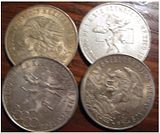 Mexico, 4-piece lot of silver 25-peso 1968 Olympics commemoratives
Mexico, 4-piece lot of silver 25-peso 1968 Olympics commemorativesKM 479, .720 silver/.5208 oz. ea. No, they're not double dies- that's just another one of my trademark "shaky hand" photos with typically awful focus. At 38 mm, these are US silver dollar sized. Two pieces are basically white and two have light goldish toning. There is a total of 2.0832 ounces ASW in this lot. I bought these for spot recently, when silver was $33.82/oz., meaning I've got $70.45 in them. I suppose I'll ask $75 unless silver really spikes drastically. I see it's gone up since I bought them. If silver drops, I'll offer 'em at my cost. (I've added some Kitco bullion charts at the bottom of this post just so we can keep an eye on silver prices.)
 Russia (Imperial), 6-piece lot of silver "wire money" kopecks, circa 1500s to about 1718
Russia (Imperial), 6-piece lot of silver "wire money" kopecks, circa 1500s to about 1718These small and rather primitive coins were struck by flattening pieces of silver wire. Interestingly, this page says the wire was made from European silver thalers. If so, the silver went from huge, elaborate coins to tiny, crude ones! Here is more info. I really don't know the exact attribution on each of the coins- that would probably take a specialist with a good eye, knowledge of the Cyrillic alphabet, and much patience. Coins like this were struck from the 1500s on up to the reign of Peter the Great, with production ceasing around 1718. Note that one piece has a horseman on it- St. George slaying the dragon- which is a common motif on both British and modern Russian coins. That piece also has a very tiny pinhole in it that somebody might have once used to sew the coin onto something. Tiny and crude these may be, but how else would you expect to get six pieces of 300-500-year-old silver coins for $12?
Side A (the sides with lettering) ~ Side B (the sides with pictorial designs)
 Straits Settlements, 1/2 cent, 1883, G+
Straits Settlements, 1/2 cent, 1883, G+KM8, copper. Apparently scarce- catalogs $75 in Fine in the 4th Edition Krause. Flattened denticles at 12:00 and 2:00 on the reverse are apparently the result of small cuds rather than any damage. $15.
 Straits Settlements, 10 cents, 1901, VF+ to XF
Straits Settlements, 10 cents, 1901, VF+ to XFKM11, .800 silver/.0697 oz. Catalogs $80.00 in XF by the 2009 catalog, and I'd say this one is close. It used to be a part of my daughter's 1901 Victorian type set until I upgraded. Asking $19.
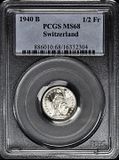
 Switzerland, 1/2 franc, 1940-B, PCGS MS68
Switzerland, 1/2 franc, 1940-B, PCGS MS68KM23, .835 silver/.0671 oz, 18.1 mm. A truly beautiful coin in top-tier plastic, this is a blast white supergem with dazzling, flashy luster. The apparent dark patches in the photos were caused by reflections. I acquired it in a recent trade and the previous owner suggested that I stick an $80 pricetag on it since it's from the early 1940s instead of the more commonly encountered late 1950s and early 1960s. Furthermore, MS68s are not terribly easy to come by, as you know. I suppose I'll ask $76, or just make me a fair offer. SOLD
 Unknown 17th-18th century copper, probably Liège 1 liard, ca. 1694-1723
Unknown 17th-18th century copper, probably Liège 1 liard, ca. 1694-1723I'm not 100% sure of what this is. I bought it in a largish lot of 17th century pieces several years back, and it was loosely attributed as a no-date (undated) Liège 1-liard piece, ca. 1694-1723. Looking at Krause, I can see that those coins are close, but not quite an exact match. It doesn't help that Krause lacks pictures for many of the types. The coats of arms here do seem similar to Liège, though. I guess Liège would have been in the Spanish Netherlands when this coin was made, but it is a city in Belgium today. The coin is rather thin and 23 mm in diameter. I'll ask $12 but will entertain counteroffers and would welcome more information. Buy this with the 1750 Liège 4-liards piece above and I'll knock five bucks off the pair. SALE PENDING

 1839 No Drapery Seated Liberty dime, G6
1839 No Drapery Seated Liberty dime, G6Light "CircCam" contrast. I'd call it VG if the reverse rim weren't a tiny bit soft. Still, it's a decent looking example. $20.
 1845 Seated Liberty dime, F12
1845 Seated Liberty dime, F12I'll call this one Fine simply by virtue of its having a full LIBERTY on the shield. Nice original grey coin. $26. SWAP PENDING
 1890 Seated dime with "CircCam" contrast
1890 Seated dime with "CircCam" contrastI'd call it VG+, I suppose. Really, the obverse looks to be Fine and the reverse G-VG, but I suppose there is a difference in the strike. It's got a random tick or two and a few light, old hairlines, but nothing too awful for a coin in this grade, I reckon. How about... umm... $8? SWAP PENDING
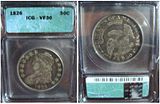 1826 Capped Bust half, ICG VF30
1826 Capped Bust half, ICG VF30Nice medium-grey original-looking coin with "CircCam" contrast. Slightly rotated dies. In an ICG VF30 holder. I do not know the Overton variety. What appears to be a small rim bump or cud at ten o'clock on the obverse is neither- I've examined that area under a loupe and it appears to be merely an odd little break in the toning. There is no apparent disturbance of the metal there and the nearby denticles are well defined. Get this slabbed VF30 at the current Redbook VF20 price. Asking $130.
{Obverse} ~ {Reverse} (with the usual apologies for poor image quality)
 Raw Barber halves for sale or trade for ones I need
Raw Barber halves for sale or trade for ones I need1908-S G4, no problems, reverse rim a bit soft as is consistent with the grade, but all legends are clear. Pretty good detail for a G4 coin $15
1909-P VG8, no problems, "LI...TY" present on headband, partial "B" shows as well $14
1909-P VG8, no problems, "LI...TY" present on headband, portions of "BER" show as well $15
1910-S VG8, reverse rim a tiny bit soft but all there, no problems, "LI...TY" shows $17
1915-D F12, dark, several micro hairlines/scuffs but not unattractive- has full LIBERTY on headband and "CircCam" contrast. $15 (below my cost)
 1881-S Morgan dollar, PCGS MS61 OGH
1881-S Morgan dollar, PCGS MS61 OGHThis coin has nice rolling cartwheel luster and subtle gold-orange peripheral toning on the obverse, while the reverse is mostly white. MS61? I've seen worse-looking stuff in MS63 holders. This piece ranks modestly on the technical plastic grade but high on eye appeal, in my opinion. You won't hear me say this very often, but the scans actually turned out a little better than I expected them to. Nevertheless, a scanner has its limitations when it comes to luster on coins, and so I'll treat you to another round of my subpar photos, as well. $48.
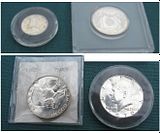 Four-piece mixed BU & Proof lot (Mercury dime, GA quarter, Franklin half, Kennedy half
Four-piece mixed BU & Proof lot (Mercury dime, GA quarter, Franklin half, Kennedy halfStandard notice: my photography is wretched and this picture does these coins no justice at all (it's a bad photo even by MY standards). Coin 1: 1941-P Mercury dime, BU (eh, whoops- looking at it under a loupe, I think maybe it's just a nice slider. Let's call it AU58, but it looks BU. Has some faint gold toning, mostly on the obverse, which was strangely exaggerated in the photo. In hand, it's got great luster (which doesn't show at all in the weird picture) and the toning is more subtle (and NOT all spotty looking like it appears in the picture). Coin 2: 1999-S GA Statehood quarter, nice DCAM clad proof (say, did you know it's good luck to buy GA quarters from somebody in GA?) Coin 3: 1962 Franklin half, brilliant proof. Not a Cameo, but a nice white proof with no haze or spots- I would call it PR65 at least. Coin 4: 1970-S silver proof Kennedy half, likewise a brilliant proof I'd call PR65 at least. Asking $38 for the lot (which is exactly Redbook price for the three bigger coins and you get the Merc for free).

 Unknown weird old token with early automobile and St Christopher
Unknown weird old token with early automobile and St ChristopherOdd but intriguing. Probably copper or bronze, 20 mm. There doesn't appear to be too much lettering to go by, so I'm in the dark on this one. I won it with a cheap eBay impulse bid a while back. One side features an early open-topped touring car with a driver and three passengers, and the other side is obviously a portrayal of St. Christopher- you can see him with his staff, carrying the Christ child on his shoulders. It was the car that hooked me at first, of course. I wondered if it could be the car that Archduke Franz Ferdinand was riding in when he and his wife were assassinated at Sarajevo in 1914, thereby indirectly sparking off World War One. It certainly looks like the same kind of car, and the passengers in the backseat have big plumed hats hats like the archduke and the duchess Sophie wore. You've gotta admit, the similarities are compelling. If it has to do with them, then I suppose we could assume this piece to be Austrian, from around 1914 or so. Then again, it might just be a generic picture of a car, and since St. Christopher on the other side was the patron saint of travelers and transportation, perhaps this was a "lucky" piece of some kind, to be carried by travelers? It certainly picked up some wear, no doubt as somebody's pocket piece. I don't know if anybody else will find this piece as interesting as I did, but who knows- maybe somebody will like it for the car on it, as I did. How about $8? Otherwise I'll just give it to my Dad, who's not a coin collector, but he is a WW1 history buff. SALE PENDING
 Screw-top coin bezels in assorted sizes
Screw-top coin bezels in assorted sizesThe cent-sized bezels are gold-colored while all of the others are silver colored. I would not recommend these for valuable coins, obviously, but they make nice inexpensive mounts for cheap keepsake coins. A few years back I took some of those gold-plated Statehood quarters from my home state and put some in these bezels, and they sold very nicely at my antique mall booth. I gave my lady boss a Peace dollar in one of these as a Christmas gift, and she was happy. Put some common Indian cents, Buffalo nickels, or Merc dimes in these and I'll bet you'll find them popular. Use needle nose pliers to gently open the crown screw, put the coin in, and screw the crown back on. Be careful not to overtighten or you could snap the stem off. $2 each
CENT size (gold color): 9 available
NICKEL size (silver color): 10 available
DIME size (silver color): 10 available
QUARTER size (silver color): 23 available
HALF DOLLAR size (silver color): 11 available 1 SOLD- 10 left
LARGE DOLLAR (Morgan/Peace/Ike, not ASE) size (silver color): 8 available
Keychain attachment (the typical inexpensive kind you see on most novelty key rings): 5 available (one free each to the first five people who buy bezels).
 Handsome pocket watch with 1883 Seated Liberty dime mounted in the case
Handsome pocket watch with 1883 Seated Liberty dime mounted in the caseThe watch is modern, brand new in the original box, with a base metal "skeleton" case revealing the 7(?)-jewel analog movement. It's a very classy-looking watch with an antique-style design. Asking only $75, which is basically my cost.
(Picture 1) - (Picture 2) - (Picture 3)
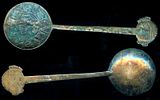 Old "MEXICO" silver souvenir spoon, marked "STERLING"
Old "MEXICO" silver souvenir spoon, marked "STERLING"Approximately 3.5" long with a 1" diameter bowl featuring a Mayan face design. 8.6 g. Marked "STERLING", but I have my doubts. I suspect it is actually "Mexican silver" (.800 fine) rather than Sterling silver (.925 fine). There is some old vedigris that has formed into hard, almost crystalline deposits. I didn't try removing it because it gives that Mayan face an ancient sort of look. Were I to venture a wild guess, I'd imagine this piece to have been made sometime between the 1930s and the 1950s or so. $3.

I orginally added this "Bid Board" section to my BST store in case I wanted to run small auctions here, but I think I'll also use it for stuff where I don't really have a firm price in mind- the my "make me an offer" stuff. So if you don't see any specific auction terms listed, just make me an offer!
 "Holey" 1851-C gold dollar
"Holey" 1851-C gold dollarThe hole goes through the right-hand side of the mintmark, but the consensus of this forum discussion (which included some specialists) is that it is indeed an 1851-C. I'm open for offers, be they cash or trade, but I should warn you that I probably overpaid for this coin. I have $300 in it, but don't let that deter you from making an offer- at worst, I'll just say "no", and keep it to hang back on my trademark "Holey Gold Hat".
Just for your reference and mine, here are some live Kitco charts, just in case they should ever be helpful.
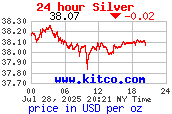

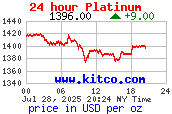
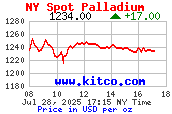
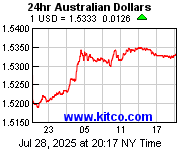

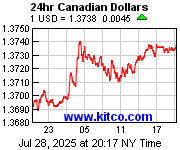

0
